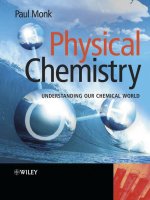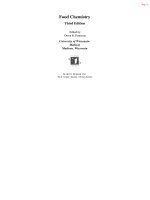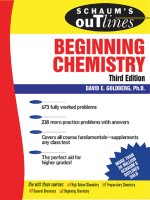Physical chemistry, third edition
Bạn đang xem bản rút gọn của tài liệu. Xem và tải ngay bản đầy đủ của tài liệu tại đây (10.32 MB, 1,405 trang )
Physical Chemistry
Third Edition
Physical
Chemistry
Third Edition
Robert G. Mortimer
Professor Emeritus
Rhodes College
Memphis, Tennessee
AMSTERDAM
•
BOSTON
•
HEIDELBERG
•
LONDON
NEW YORK
•
OXFORD
•
PARIS
•
SAN DIEGO
SAN FRANCISCO
•
SINGAPORE
•
SYDNEY
•
TOKYO
Academic Press is an imprint of Elsevier
Cover Design: Eric DeCicco
Cover Image: © iStockphoto
Elsevier Academic Press
30 Corporate Drive, Suite 400, Burlington, MA 01803, USA
525 B Street, Suite 1900, San Diego, CA 92101-4495, USA
84 Theobald’s Road, London WC1X 8RR, UK
This book is printed on acid-free paper.
∞
Copyright © 2008, Elsevier Inc. All rights reserved.
No part of this publication may be reproduced or transmitted in any form or by any means,
electronic or mechanical, including photocopy, recording, or any information storage
and retrieval system, without permission in writing from the publisher.
Permissions may be sought directly from Elsevier’s Science & Technology Rights Department in
Oxford, UK: phone: (+44) 1865 843830, fax: (+44) 1865 853333, E-mail:
You may also complete your request on-line via the Elsevier homepage (), by
selecting “Customer Support” and then “Obtaining Permissions.”
Library of Congress Catalog-in-Publishing Data
Mortimer, Robert G.
Physical chemistry / Robert G. Mortimer. – 3rd ed.
p. cm.
Includes bibliographical references and index.
ISBN 978-0-12-370617-1 (hardcover : alk. paper)
1. Chemistry, Physical and theoretical. I. Title.
QD453.2.M67 2008
541–dc22
2008007675
British Library Cataloguing in Publication Data
A catalogue record for this book is available from the British Library
ISBN-13: 978-0-12-370617-1
For information on all Elsevier Academic Press publications
visit our Web site at www.books.elsevier.com
Printed in Canada
080910 987654321
To my wife, Ann,
and to my late father, William E. Mortimer,
who was responsible for my taking my first chemistry course
Contents
Periodic Table
Inside front cover
List of Numerical Tables in Appendix A
Inside front cover
Information Tables
Inside back cover
Preface xv
Acknowledgments xvii
Part 1 Thermodynamics and the Macroscopic
Description of Physical Systems 1
Chapter 1 The Behavior of Gases and Liquids 3
1.1 Introduction 4
1.2 Systems and States in Physical Chemistry 12
1.3 Real Gases 21
1.4 The Coexistence of Phases and the Critical Point 27
Chapter 2 Work, Heat, and Energy: The First Law of
Thermodynamics 39
2.1 Work and the State of a System 40
2.2 Heat 51
2.3 Internal Energy: The First Law of Thermodynamics 55
2.4 Calculation of Amounts of Heat and Energy Changes 60
2.5 Enthalpy 74
2.6 Calculation of EnthalpyChangesofProcesses withoutChem-
ical Reactions 81
2.7 Calculation of Enthalpy Changes of a Class of Chemical
Reactions 86
2.8 Calculation of Energy Changes of Chemical Reactions 94
Chapter 3 The Second and Third Laws of Thermodynamics:
Entropy 105
3.1 The Second Law of Thermodynamics and the Carnot Heat
Engine 106
vii
viii Contents
3.2 The Mathematical Statement of the Second Law:
Entropy 114
3.3 The Calculation of Entropy Changes 121
3.4 Statistical Entropy 133
3.5 The Third Law of Thermodynamics and Absolute
Entropies 139
Chapter 4 The Thermodynamics of Real Systems 151
4.1 Criteria for Spontaneous Processes and for Equilibrium:
The Gibbs and Helmholtz Energies 152
4.2 Fundamental Relations for Closed Simple Systems 158
4.3 Additional Useful Thermodynamic Identities 167
4.4 Gibbs Energy Calculations 175
4.5 Multicomponent Systems 182
4.6 Euler’s Theorem and the Gibbs–Duhem Relation 188
Chapter 5 Phase Equilibrium 199
5.1 The Fundamental Fact of Phase Equilibrium 200
5.2 The Gibbs Phase Rule 202
5.3 Phase Equilibria in One-Component Systems 205
5.4 The Gibbs Energy and Phase Transitions 215
5.5 Surfaces in One-Component Systems 222
5.6 Surfaces in Multicomponent Systems 230
Chapter 6 The Thermodynamics of Solutions 237
6.1 Ideal Solutions 238
6.2 Henry’s Law and Dilute Nonelectrolyte Solutions 248
6.3 Activity and Activity Coefficients 258
6.4 The Activities of Nonvolatile Solutes 267
6.5 Thermodynamic Functions of Nonideal Solutions 275
6.6 Phase Diagrams of Nonideal Mixtures 282
6.7 Colligative Properties 292
Chapter 7 Chemical Equilibrium 303
7.1 Gibbs Energy Changes and the Equilibrium
Constant 304
7.2 Reactions Involving GasesandPure Solids orLiquids 310
7.3 Chemical Equilibrium in Solutions 315
7.4 Equilibria in Solutions of Strong Electrolytes 328
7.5 Buffer Solutions 331
7.6 The Temperature Dependence of Chemical Equilibrium.
The Principle of Le Châtelier 335
7.7 Chemical Equilibrium and Biological Systems 343
Chapter 8 The Thermodynamics of Electrochemical Systems 351
8.1 The Chemical Potential and the Electric Potential 352
8.2 Electrochemical Cells 354
8.3 Half-Cell Potentials and Cell Potentials 361
8.4 The Determination of Activities and Activity Coefficients
of Electrolytes 371
8.5 Thermodynamic InformationfromElectrochemistry 374
Contents ix
Part 2 Dynamics 381
Chapter 9 Gas Kinetic Theory: The Molecular Theory of Dilute Gases at
Equilibrium 383
9.1 Macroscopic and Microscopic States of Macroscopic
Systems 384
9.2 A Model System to Represent a Dilute Gas 386
9.3 The Velocity Probability Distribution 394
9.4 The Distribution of Molecular Speeds 405
9.5 The Pressure of a Dilute Gas 411
9.6 Effusion and Wall Collisions 416
9.7 The Model System with Potential Energy 418
9.8 The Hard-Sphere Gas 422
9.9 The Molecular Structure of Liquids 434
Chapter 10 Transport Processes 441
10.1 The Macroscopic Description of Nonequilibrium
States 442
10.2 Transport Processes 444
10.3 The Gas Kinetic Theory of Transport Processes in Hard-
Sphere Gases 460
10.4 Transport Processes in Liquids 467
10.5 Electrical Conduction in Electrolyte Solutions 475
Chapter 11 The Rates of Chemical Reactions 485
11.1 The Macroscopic Description of Chemical Reaction
Rates 486
11.2 Forward Reactions with One Reactant 488
11.3 Forward Reactions with More Than One Reactant 499
11.4 Inclusion of a Reverse Reaction. Chemical
Equilibrium 507
11.5 A Simple Reaction Mechanism: Two Consecutive
Steps 510
11.6 Competing Reactions 513
11.7 The Experimental Study of Fast Reactions 515
Chapter 12 Chemical Reaction Mechanisms I: Rate Laws and
Mechanisms 523
12.1 Reaction Mechanisms and Elementary Processes in
Gases 524
12.2 Elementary Processes in Liquid Solutions 527
12.3 The Temperature Dependence of Rate Constants 533
12.4 Reaction Mechanisms and Rate Laws 540
12.5 Chain Reactions 556
Chapter 13 Chemical Reaction Mechanisms II: Catalysis and Miscellaneous
Topics 565
13.1 Catalysis 566
13.2 Competing Mechanisms and the Principle of Detailed
Balance 583
13.3 Autocatalysis and Oscillatory Chemical Reactions 585
13.4 The Reaction Kinetics of Polymer Formation 589
x Contents
13.5 Nonequilibrium Electrochemistry 595
13.6 Experimental Molecular Study of Chemical Reaction
Mechanisms 608
Part 3 The Molecular Nature of Matter 617
Chapter 14 Classical Mechanics and the Old Quantum Theory 619
14.1 Introduction 620
14.2 Classical Mechanics 621
14.3 Classical Waves 629
14.4 The Old Quantum Theory 640
Chapter 15 The Principles of Quantum Mechanics. I. De Broglie Waves and
the Schrödinger Equation 653
15.1 De Broglie Waves 654
15.2 The Schrödinger Equation 657
15.3 The Particle in a Box and the Free Particle 663
15.4 The Quantum Harmonic Oscillator 674
Chapter 16 The Principles of Quantum Mechanics. II. The Postulates of
Quantum Mechanics 683
16.1 The First Two Postulates of Quantum Mechanics 684
16.2 TheThird Postulate. MathematicalOperatorsand Mechanical
Variables 684
16.3 The Operator Corresponding to a Given Variable 688
16.4 Postulate 4 and Expectation Values 696
16.5 The Uncertainty Principle of Heisenberg 711
16.6 Postulate 5. Measurements and the Determination of the
State of a System 717
Chapter 17 The Electronic States of Atoms. I. The Hydrogen Atom 725
17.1 The Hydrogen Atom and the Central Force System 726
17.2 The Relative Schrödinger Equation. Angular
Momentum 729
17.3 The Radial Factor in the Hydrogen Atom Wave Function.
The Energy Levels of the Hydrogen Atom 736
17.4 The Orbitals of the Hydrogen-Like Atom 741
17.5 Expectation Values in the Hydrogen Atom 749
17.6 TheTime-DependentWave Functionsofthe HydrogenAtom 753
17.7 The Intrinsic Angular Momentum of the Electron.
“Spin” 755
Chapter 18 The Electronic States ofAtoms. II.The Zero-OrderApproximation
for Multielectron Atoms 763
18.1 The Helium-Like Atom 764
18.2 The Indistinguishabilityof Electrons andthePauli Exclusion
Principle 766
18.3 The Ground State of the HeliumAtom in Zero Order 768
18.4 Excited States of the Helium Atom 772
18.5 Angular Momentum in the Helium Atom 774
Contents xi
18.6 The Lithium Atom 781
18.7 Atoms with More Than Three Electrons 784
Chapter 19 The Electronic States of Atoms. III. Higher-Order
Approximations 789
19.1 The Variation Method and Its Application to the Helium
Atom 790
19.2 The Self-Consistent Field Method 796
19.3 The Perturbation Method and ItsApplication to the Ground
State of the Helium Atom 799
19.4 Excited Statesof the HeliumAtom.Degenerate Perturbation
Theory 803
19.5 The Density Functional Method 805
19.6 Atoms with More Than Two Electrons 806
Chapter 20 The Electronic States of Diatomic Molecules 823
20.1 The Born–OppenheimerApproximation and the Hydrogen
Molecule Ion 824
20.2 LCAOMOs.Approximate MolecularOrbitalsThatAreLinear
Combinations of Atomic Orbitals 833
20.3 Homonuclear Diatomic Molecules 838
20.4 Heteronuclear Diatomic Molecules 851
Chapter 21 The Electronic Structure of Polyatomic Molecules 867
21.1 The BeH
2
Molecule and the sp Hybrid Orbitals 868
21.2 The BH
3
Molecule and the sp
2
Hybrid Orbitals 871
21.3 The CH
4
,NH
3
, and H
2
O Molecules
and the sp
3
Hybrid Orbitals 873
21.4 Molecules with Multiple Bonds 878
21.5 TheValence-BondDescription of PolyatomicMolecules 881
21.6 Delocalized Bonding 885
21.7 The Free-Electron Molecular Orbital Method 892
21.8 Applications of Symmetry to Molecular Orbitals 894
21.9 Groups of Symmetry Operators 896
21.10 More Advanced Treatments of Molecular Electronic
Structure. Computational Chemistry 904
Chapter 22 Translational, Rotational, and Vibrational States of Atoms and
Molecules 915
22.1 The Translational States of Atoms 916
22.2 The Nonelectronic States of Diatomic Molecules 919
22.3 Nuclear Spins and Wave Function Symmetry 930
22.4 The Rotation and Vibration of Polyatomic
Molecules 933
22.5 The Equilibrium Populations of Molecular States 942
Chapter 23 Optical Spectroscopy and Photochemistry 949
23.1 Emission/Absorption Spectroscopy andEnergy Levels 950
23.2 The Spectra of Atoms 959
23.3 Rotational and Vibrational Spectra of Diatomic
Molecules 961
23.4 Electronic Spectra of Diatomic Molecules 972
xii Contents
23.5 Spectra of Polyatomic Molecules 975
23.6 Fluorescence, Phosphorescence, andPhotochemistry 979
23.7 Raman Spectroscopy 985
23.8 Other Types of Spectroscopy 991
Chapter 24 Magnetic Resonance Spectroscopy 1001
24.1 Magnetic Fields and Magnetic Dipoles 1002
24.2 Electronic and Nuclear Magnetic Dipoles 1006
24.3 Electron Spin Resonance Spectroscopy 1010
24.4 Nuclear Magnetic Resonance Spectroscopy 1014
24.5 Fourier Transform NMR Spectroscopy 1024
Part 4 The Reconciliation of the Macroscopic and Molecular
Theories of Matter 1037
Chapter 25 Equilibrium Statistical Mechanics I. The Probability
Distribution for Molecular States 1039
25.1 The Quantum Statistical Mechanics of a Simple Model
System 1040
25.2 The Probability Distribution for a Dilute Gas 1047
25.3 The Probability Distribution and the Molecular Partition
Function 1055
25.4 The Calculation of Molecular Partition Functions 1064
Chapter 26 Equilibrium Statistical Mechanics. II. Statistical
Thermodynamics 1081
26.1 The Statistical Thermodynamics of a Dilute Gas 1082
26.2 Working Equations for the Thermodynamic Functions of a
Dilute Gas 1089
26.3 Chemical Equilibrium in Dilute Gases 1101
26.4 The Activated Complex Theory of Bimolecular Chemical
Reaction Rates in Dilute Gases 1106
26.5 Miscellaneous Topics in Statistical
Thermodynamics 1116
Chapter 27 Equilibrium Statistical Mechanics. III. Ensembles 1121
27.1 The Canonical Ensemble 1122
27.2 Thermodynamic Functions in the Canonical
Ensemble 1128
27.3 The Dilute Gas in the Canonical Ensemble 1130
27.4 Classical Statistical Mechanics 1133
27.5 Thermodynamic Functions in the Classical Canonical
Ensemble 1141
27.6 The Classical Statistical Mechanics of Dense Gases and
Liquids 1147
Chapter 28 The Structure of Solids, Liquids, and Polymers 1153
28.1 The Structure of Solids 1154
28.2 Crystal Vibrations 1162
28.3 The Electronic Structure of Crystalline Solids 1171
28.4 Electrical Resistance in Solids 1179
Contents
xiii
28.5 The Structure of Liquids 1184
28.6 Approximate Theories of Transport Processes in
Liquids 1188
28.7 Polymer Conformation 1194
28.8 Polymers in Solution 1198
28.9 Rubber Elasticity 1200
28.10 Nanomaterials 1205
Appendices 1209
A. Tables of Numerical Data 1209
B. Some Useful Mathematics 1235
C. A Short Table of Integrals 1257
D. Some Derivations of Formulas and Methods 1261
E. Classical Mechanics 1267
F. Some Mathematics Used in Quantum Mechanics 1275
G. The Perturbation Method 1283
H. The Hückel Method 1289
I. Matrix Representations of Groups 1293
J. Symbols Used in This Book 1303
K. Answers to Numerical Exercises and Odd-Numbered
Numerical Problems 1309
Index 1351
Preface
This is the third edition of a physical chemistry textbook designed for a two-semester
undergraduate physical chemistry course. The physical chemistry course is often the
first opportunity that a student has to synthesize descriptive, theoretical, and mathe-
matical knowledge about chemistry into a coherent whole. To facilitate this synthe-
sis, the book is constructed about the idea of defining a system, studying the states
in which it might be found, and analyzing the processes by which it can change
its state.
The book is divided into four parts. The first part focuses on the macroscopic
properties of physical systems. It begins with the descriptive study of gases and liquids,
and proceeds to the study of thermodynamics, which is a comprehensive macroscopic
theory of the behavior of material systems. The second part focuses on dynamics,
including gas kinetic theory, transport processes, and chemical reaction kinetics. The
third part presents quantum mechanics and spectroscopy. The fourth part presents the
relationship between molecular and macroscopic properties of systems through the
study of statistical mechanics. This theory is applied to the structure of condensed
phases. The book is designed so that the first three parts can be studied in any order,
while the fourth part is designed to be a capstone in which the other parts are integrated
into a cohesive whole.
In addition to the standard tables of integrals and numerical values of various
properties, the book contains several appendices that expand on discussions in the body
of the text, such as more detailed discussions of perturbation theory, group theory, and
several mathematical topics. Each chapter begins with a statement of the principal facts
and ideas that are presented in the chapter. There is a summary at the end of each chap-
ter to assist in synthesizing the material of each chapter into a coherent whole. There
are also marginal notes throughout the chapters that present biographical information
and some comments. Each chapter contains examples that illustrate various kinds of
calculations, as well as exercises placed within the chapter. Both these exercises and
the problems at the end of each section are designed to provide practice in applying
techniques and insights obtained through study of the chapter.
Answers to all of the numerical exercises and to the odd-numbered numerical
problems are placed in Appendix K. A solutions manual, with complete solutions
to all exercises and all odd-numbered problems, is available from the publisher. An
instructor’s manual with solutions to the even-numbered problems is available on-line
to instructors. The instructor can choose whether to allow students to have access to
the solutions manual, but can assign even-numbered problems when he or she wants
the students to work problems without access to solutions.
xv
xvi Preface
The author encourages students and instructors to comment on any part of the book;
please send comments and suggestions to the author’s attention.
Robert G. Mortimer
2769 Mercury St.
Bartlett, TN 38134, USA
Acknowledgments
The writing of the first edition of this book was begun during a sabbatical leave from
Rhodes College, and continued during summer grants from the Faculty Development
Committee of Rhodes College. It is a pleasure to acknowledge this support.
It has been my pleasure to have studied with many dedicated and proficient teachers,
and I acknowledge their influence, example, and inspiration. I am also grateful for the
privilege of working with students, whose efforts to understand the workings of the
physical universe make teaching the most desirable of all professions.
I have benefited from the expert advice of many reviewers. These include:
Jonas Goldsmith Bryn Mawr College
Jason D. Hofstein Sienna College
Daniel Lawson University of Michigan–Dearborn
Jennifer Mihalick University of Wisconsin–Oshkosh
Cynthia M. Woodbridge Hillsdale College
and the reviewers of the previous editions.All of thesereviewersgavesoundadvice,and
some of them went beyond the call of duty in searching out errors and unclarities and
in suggesting remedies. The errors that remain are my responsibility, not theirs.
I wish to thank the editorial staff of Elsevier/Academic Press for their guidance
and help during a rather long and complicated project, and also wish to thank Erica
Ellison, who was a valuable consultant. I thank my wife, Ann, for her patience, love,
and support during this project.
xvii
1
Thermodynamics and the Macroscopic
Description of Physical Systems
1
The Behavior of Gases and Liquids
PRINCIPAL FACTS AND IDEAS
1. The principal goal of physical chemistry is to understand the properties
and behavior of material systems and to apply this understanding in
useful ways.
2. The state of a system is specified by giving the values of a certain number
of independent variables (state variables).
3. In an equilibrium one-phase fluid system of one substance, three
macroscopic variables such as temperature, volume, and amount of
substance can be independent variables and can be used to specify the
macroscopic equilibrium state of the system. At least one of the variables
used to specify the state of the system must be proportional to the size of
the system (be extensive). Other macroscopic variables are mathematical
functions of the independent variables.
4. The intensive state, which includes only intensive variables (variables
that are independent of the size of the system), is specified by only two
variables in the case of an equilibrium one-phase fluid system of one
substance.
5. Nonideal gases and liquids are described mathematically by various
equations of state.
6. The coexistence of phases can be described mathematically.
7. The liquid–gas coexistence curve terminates at the critical point, beyond
which there is no distinction between liquid and gas phases.
8. The law of corresponding states asserts that in terms of reduced variables,
all substances obey the same equation of state.
3
4 1 The Behavior of Gases and Liquids
1.1 Introduction
Antoine Laurent Lavoisier, 1743–1794,
was a great French chemist who was
called the “father of modern chemistry”
because of his discovery of the law of
conservation of mass. He was
beheaded during the French Revolution
because of his involvement in his
father-in-law’s firm, which was
employed by the royal government to
collect taxes. It is said that he arranged
with a friend to observe his head to see
how long he could blink his eyes after
his head was severed. He blinked for
15 seconds.
This book is a textbook for a standard two-semester physical chemistry course at the
undergraduate level. Physical chemistry involves both physics and chemistry. Physics
has been defined as the study of the properties of matter that are shared by all sub-
stances, whereas chemistry has been defined as the study of the properties of indi-
vidual substances. Chemistry grew out of the ancient occult art of alchemy, which
involved among other things the attempted transmutation of cheaper materials into
gold. Chemistry began as a completely experimental science. Substances were named
and studied without reference to their molecular structures. Sulfuric acid was called
“oil of vitriol,” and chemists memorized the fact that when copper was treated with oil
of vitriol a solution of “blue vitriol” (now known as copper(II) sulfate) resulted. In the
late 18th century, Lavoisier established the law of conservation of mass in chemical
reactions, and Proust established the law of definite proportion. In order to explain
these laws, Dalton proposed his atomic theory in 1803, as well as announcing the
law of multiple proportions. With this theory, chemistry could evolve into a molecular
science, with properties of substances tied to their molecular structures.
Joseph Proust, 1754–1826, was a
French chemist who was the first to
isolate sugar from grapes.
John Dalton, 1766–1844, was an
English schoolmaster and chemist.
After he became a famous chemist, he
continued to teach at what we would
now call the elementary school level.
Systems
We call any object that we wish to study our system. A large system containing many
atoms or molecules is called a macroscopic system, and a system consisting of a single
atom or molecule is called a microscopic system. We consider two principal types of
properties of systems. Macroscopic properties such as temperature and pressure apply
only to a macroscopic system and are properties of the whole system. They can be
observed and studied without reference to the molecular nature of matter. Microscopic
properties such as kinetic energy and momentum are mechanical in nature. They apply
to either macroscopic or microscopic systems.
The study of macroscopic properties involves thermodynamics, which is the major
topic of this volume, along with gas kinetic theory, transport processes, and reaction
kinetics. Quantum mechanics, spectroscopy, and statistical mechanics are molecular
topics and are discussed in Parts 3 and 4 of this textbook.
Mathematics in Physical Chemistry
The study of any physical chemistry topics requires mathematics. Galileo once wrote,
“The bookof nature iswrittenin the languageofmathematics.”We will usemathematics
in two different ways. First, we will use it to describe the behavior of systems without
explaining the origin of the behavior. Second, we will use it to develop theories that
explain why certain behaviors occur. This chapter is an example of the first usage, and
the next chapter is an example of the second usage.
Galileo Galilei, 1564–1642, was a great
Italian mathematician and physicist. He
refuted the assertion of Aristotle that a
heavier object should fall faster than a
lighter one and is said to have dropped
two balls of different masses from the
leaning tower of Pisa to demonstrate
that they fell at the same rate. He
supported the hypothesis of Copernicus
that the earth revolves around the sun
and was convicted of heresy in 1633
by the Roman Catholic Church for this
belief. He spent the rest of his life under
house arrest.
Much of the mathematical education that physical chemistry students have received
has focused on mathematical theory rather than on practical applications. A student
who was unable to apply an elementary calculus technique once said to the author,
“I know that was in the calculus course, but nobody told me that I would ever have
to use it.” Mathematical theory is not always important in physical chemistry, but you
1.1 Introduction 5
need to be able to apply mathematical methods. There are several books that cover the
application of mathematics to problems in physical chemistry.
1
Arithmetic is the principal branch of numerical mathematics. It involves carrying
out operations such as addition, subtraction, multiplication, and division on actual
numbers. Geometry, algebra, and calculus are parts of symbolic mathematics, in which
symbols that represent numerical quantities and operations are manipulated without
doing the numerical operations. Both kinds of mathematics are applied in physical
chemistry.
Mathematical Functions
A mathematical function involves two kinds of variables: An independent variable is
one to which we can assign a value. A mathematical function is a rule that delivers the
value of a dependent variable when values are assigned to the independent variable or
variables. A function can be represented by a formula, a graph, a table, a mathematical
series, and so on. Consider the ideal gas law :
PV nRT (1.1-1)
In this equation P represents the pressure of the gas, V represents its volume, n rep-
resents the amount of substance in moles, T represents the absolute temperature, and
R stands for the ideal gas constant. The ideal gas law does a good but not perfect
job of representing the equilibrium behavior of real gases under ordinary conditions.
It is more nearly obeyed if the pressure of the gas is made smaller. A gas that is at a
sufficiently low pressure that it obeys the ideal gas law to an adequate approximation
is called a dilute gas.Anideal gas is defined to obey this equation for all pressures
and temperatures. An ideal gas does not exist in the real world, and we call it a model
system.Amodel system is an imaginary system designed to resemble some real system.
A model system is useful only if its behavior mimics that of a real system to a useful
degree and if it can be more easily analyzed than the real system.
We can solve the ideal gas law for V by symbolically dividing by P:
V
nRT
P
(1.1-2)
The right-hand side of Eq. (1.1-2) is a formula that represents a mathematical function.
The variables T , P, and n are independent variables, and V is the dependent variable.
If you have the numerical values of T , P , and n, you can now carry out the indicated
arithmetic operations to find the value of V . We can also solve Eq. (1.1-1) for P by
symbolically dividing by V :
P
nRT
V
(1.1-3)
We have now reassigned V to be one of the independent variables and P to be the
dependent variable. This illustrates a general fact: If you have an equation containing
1
Robert G. Mortimer, Mathematics for Physical Chemistry, 3rd ed., Academic Press, San Diego, CA,
U.S.A., 2005; JamesR.Barrante,Applied Mathematics for Physical Chemistry, 3rd ed.,PearsonPrentice Hall,
Upper Saddle River, NJ, 2004; Donald A. McQuarrie, Mathematical Methods for Scientists and Engineers,
University Science Books, 2003.
6 1 The Behavior of Gases and Liquids
several variables, you can manipulate the equation symbolically to turn any one of
them into the dependent variable.
The ideal gas law might not be accurate enough for some gases under some condi-
tions. If so, we can find some other function that will give the value of the pressure to
greater accuracy. It is an experimental fact that the pressure of a gas or liquid of one
substance at equilibrium is given by a function that depends on only three independent
variables. We represent such a function by
P P(T , V , n) (1.1-4)
A mathematician would write P f (T , V , n) for the functional relation in Eq. (1.1-4),
using the letter P for the variable and the letter f for the function. Chemists have
too many variables to use two letters for each variable, so we use the same letter for
the variable and the function. A functional relation that relates P, V , T , and n for a
gas or a liquid at equilibrium is called an equation of state and is said to represent
the volumetric behavior of the gas or liquid. We will introduce several equations of
state later in this chapter.
EXAMPLE 1.1
Assume that the volume of a liquid is a linearly decreasing function of P, is a linearly
increasing function of T , and is proportional to n. Write a formula expressing this functional
relationship.
Solution
Let V
0
represent the volume at some reference temperature T
0
, some reference pressure P
0
,
and some reference amount of substance n
0
.
V V
0
n
n
0
[
1 −k(P − P
0
) + a(T − T
0
)
]
nV
m0
[
1 −k(P − P
0
) + a(T − T
0
)
]
where k and a are constants and where V
m
represents the molar volume, equal to V/n, and
V
m0
represents V
0
/n
0
.
A two-dimensional graph can represent a function of one independent variable.
You plot the value of the independent variable on the horizontal axis and represent
the value of the dependent variable by the height of a curve in the graph. To make a
two-dimensional graph that represents the ideal gas law, we must keep two of the three
independent variables fixed. Figure 1.1a shows a set of graphical curves that represent
the dependence of P on V for an ideal gas for n 1.000 mol and for several fixed
values of T .
A three-dimensional graph can represent a function of two independent variables.
Figure 1.1b shows a perspective view of a graphical surface in three dimensions that
represents the dependence of P on V and T for an ideal gas with a fixed value of n
(1.000 mol). Just as the height of a curve in Figure 1.1a gives the value of P for a
particular value of V , the height of the surface in Figure 1.1b gives the value of P for
a particular value of T and a particular value of V . Such graphs are not very useful for
numerical purposes, but help in visualizing the general behavior of a function of two
independent variables.









